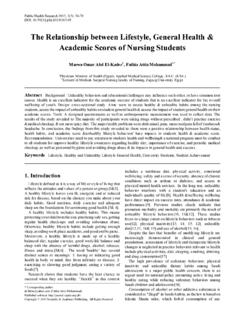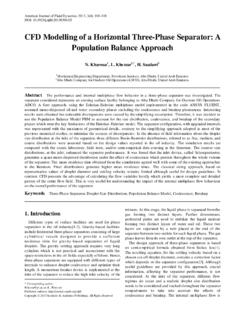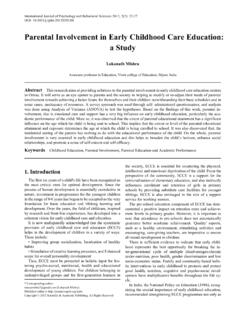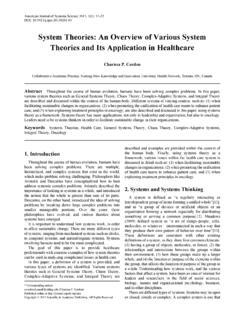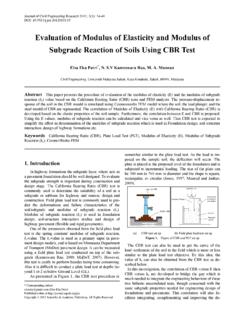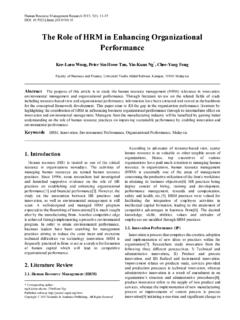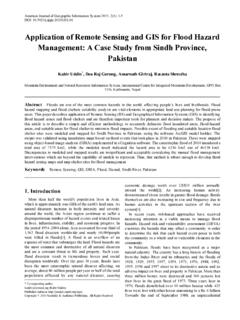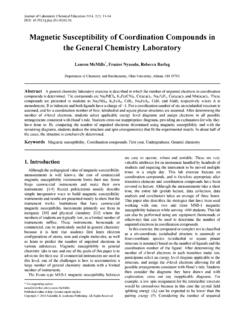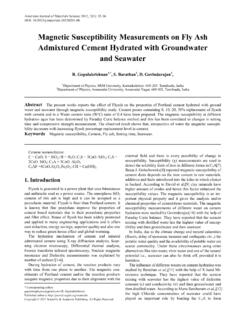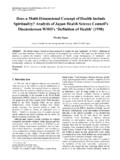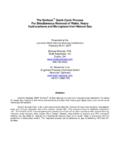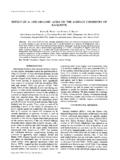Transcription of Removal of pH, TDS and Color from Textile Effluent …
1 Resources and Environ ment 2013, 3(5): 101-114 DOI: Removal of pH, TDS and Color from Textile Effluent by using coagulants and Aquatic/Non Aquatic Plants as Adsorbents As hraful Is lam, Arun Kanti Guha* Dep art ment of Text ile En gin eerin g, Southeast University, Banani, Dhaka 1213 Abs t rac t The pH of Textile Effluent is generally h igh because of use of many alkaline substances in Textile p rocessing. The total dissolved solids (TDS) are those solids remain as soluble form in Textile Effluent . There are several methods available for Removal of TDS and Color fro m Textile Effluent such as, ion exchange, coagulation and flocculation, biological decolorization, adsorption etc.
2 Among all these methods adsorption is still a procedure of choice for TDS and Color Removal . Several naturally occurring aquatic/non aquatic plants have been used in this work as adsorbents. These were water hyacinth, water lily and bark of plantain plant (banana). All of three p lants could be useful for adsorption of pollutants but considering all experimental results the remarkab le result was achieved in case of adsorption of pollutants on plantain plant (banana) bar k fro m in let Effluent of Echotex Ltd; Chandra, Gazipur, Bangladesh. Both the pH and TDS Removal obtained in this case, pH values were (before t reatment) and (after treat ment) and TDS values were 2700 mg/ L (before treat ment) and 2600 mg/L (after treatment).
3 Different comb inations of coagulants were also used for Color Removal and sludge separation. The best Color Removal and sludge separation were obtained in case of FeSO4 + Ca O. Ke y wo r ds pH, Color , TDS, Removal , Textile Effluent , Coagulation, Adsorption 1. Introduction Considering both volume and composition, the wastewater produced by the Textile industry is the most polluting among all industrial sectors[1]. Effluent fro m the Textile industry commonly contains high concentrations of organic and inorganic chemica ls and are characterized by high Chemical Oxygen Demand (COD), Biological Oxygen Demand (BOD), Total Dissolved Solids (TDS), p H, Total Suspended Solids (TSS) values and low Dissolved Oxygen (DO) value as well as strong Color .
4 The major concern with Color is its aesthetic character at the point of discharge with respect to the visibility of the receiving waters[2]. In the near future, most European countries will issue stricter standards on colored waste streams . It is li ke ly t h at Text i le in d u s t ries will be forced to remove residual dyestuffs from wastewater before discharging them into receiving waters[2] . The presence of TDS in water may a ffect its taste. High hardness in con junction with h igh alkalin ity o r sulfates causes scale. A la xat ive effect can be caused by high sulfate content.
5 Abnormally h igh or lo w d issolved solids disturb osmotic balance of native species. Disposal of the salt laden * Corresponding author: arunguha70@y (Arun Kanti Guha) Published online at Copyright 2013 Scientific & Academic Publishing. All Rights Reserved effluents into ground and surface water bodies cause pollution and render them unfit for do mestic, industrial and agricultural use. High salt concentration interferes with proper operation of biological wastewater treatment plant. The change in density of water causes trouble in floatation and sedimentation.
6 High salt content may cause an increase in non-settle able suspended solids. Higher doses of salt are toxic to aquatic organisms as they expose the organisms to changes in osmotic pressure, causing swelling or dehydration. The quality of irrigation water mainly depends on its salt content and the proportion of sodium to other ions. Sodium chloride corrodes steel and sodium sulfate corrodes concrete. In the dyeing and finishing processes a considerable amount of Effluent is generated, which is very toxic and contains strong Color , a large amount of suspended solids, a highly fluctuating pH, high temperature, COD, BOD etc.
7 [3]. Because of these characteristics, treatment of text ile wastewater is an essential require ment before it is being disposed to natural water system[4a ]. There are many methods of Effluent treatment such as, ion exchange[4b], coagulation and flocculation[4c ], oxidation[4d], reverse osmosis[4e], bio logical decolonization[4f] and adsorption[4g] to reduce pH, Color and TDS fro m Textile Effluent , among them use of coagulants has been applied traditionally or mostly in Bangladesh. Phytoremediation, the use of trees of plants to re mediate contaminated soil or water, is a relative ly new 102 Ashraful Islam et a l.
8 : Remov al of p H, TDS and Color from Textile Eff luent by using Coagu lants and Aquatic/Non Aquatic Plants as Adsorbents approach which is considered more cost-effective and environment-friendly. The major benefits of using aquatic plant-based treatment system are much lesser energy required, co mpletely natural system and very easy to regenerate. Several p lants species, such as water lettuce (Pistia stratiotes), water lilies (Nymphaea spontanea), parrot feather (Myriophylhum aquaticum), creeping primrose (Ludwigina palustris), watermint (Mentha aquatic) etc.
9 Have been studied to determine their potentiality in accumulating heavy metals or other relevant polluting substances[5]. The traditional view of many aquatic plants is that they are invasive weeds that require strict control. Ho wever, the increased pollution in the world 's rivers and lakes has led to the discovery that aquatic plants can be one of the most effective tools for extracting unwanted nutrients from water. Aquatic plants remove pollutants by directly ass imi lat in g them into their tissue, and by providing a suitable environment for microorganisms to transform pollutants and reduce their concentrations[6].
10 Literature survey showed that Eucalyptus bark has been used as adsorbent for the Removal of reactive dyes[7] fro m Te xt ile ef fluent. The water hyacinth is co mmonly used for wastewater treatment in tropica l and subtropical climates. Because it floats on the water's surface, it is not rooted and it is easy to harvest. The water hyacinth can remove large amounts of nitrogen and phosphorus from water. Its roots also can absorb sulfur, calciu m, magnesium, potassium, iron, zinc and manganese[6]. Water lilies do several things to imp rove the quality of lakes and ponds.
